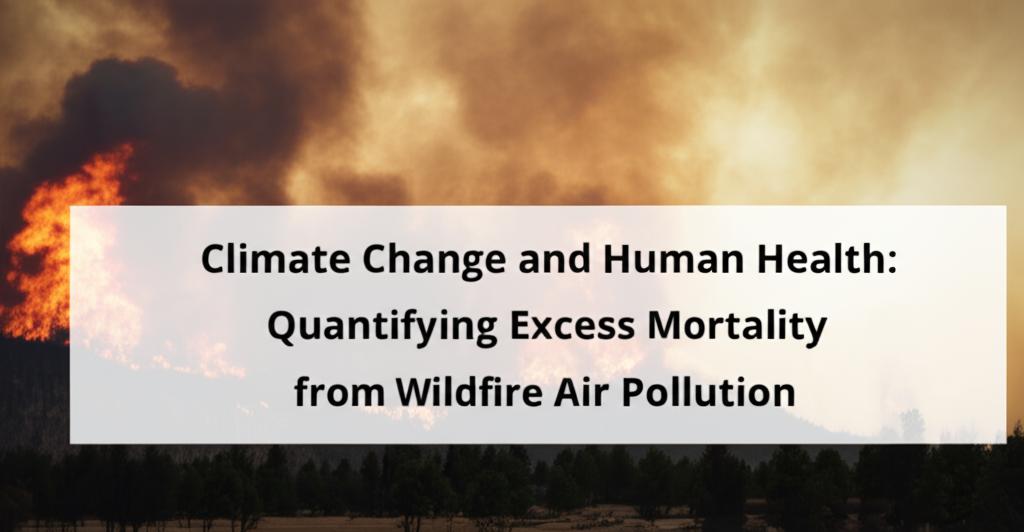Climate change is a significant driver in the increased risk and severity of wildfires globally, leading to a dangerous feedback loop. Rising global temperatures, a primary consequence of human activities like burning fossil fuels, result in drier conditions, extended droughts, and altered weather patterns. These factors make forests and other landscapes more susceptible to ignition and contribute to larger, more intense, and harder-to-control wildfires.
The smoke from these escalating wildfires poses a substantial and growing threat to human health worldwide. This smoke is a complex mixture of pollutants, including fine particulate matter (PM2.5), black carbon, carbon monoxide, nitrogen oxides, and hundreds of other toxins. These particles are small enough to be inhaled deep into the lungs and can even enter the bloodstream, leading to a range of adverse health outcomes.
Quantifying Excess Mortality:Recent studies have begun to quantify the devastating impact of wildfire air pollution on human mortality, directly linking it to climate change.
- A study published in Nature Communications Earth & Environment and highlighted by Oregon State University in May 2025, found that human-caused climate change contributed to an estimated 15,000 additional deaths from wildfire air pollution in the continental United States between 2006 and 2020. The total number of deaths linked to wildfire PM2.5 during this period was estimated at 164,000. The year 2020, marked by significant fires in the Pacific Northwest, California, Colorado, and Arizona, accounted for approximately 35% of these climate-change-attributed deaths.
- This same research estimated the economic burden associated with these 15,000 excess deaths at $160 billion. This figure considers lost productivity, healthcare expenses, and the value of statistical life. The economic impact was most pronounced in states like California, Oregon, and Washington.
- Projections indicate that without significant efforts to mitigate climate change, mortality from climate-driven wildfire smoke in the U.S. could increase by at least 50% by mid-century (relative to the decade ending 2020), with associated annual damages reaching $244 billion.
- Globally, a study published in The Lancet and highlighted in December 2024, estimated that over 1.5 million people die annually from illnesses caused by exposure to pollution from wildland fires. Of these, approximately 450,000 are cardiovascular deaths and 220,000 are respiratory deaths. This study also noted that over 90% of these deaths occur in low- and middle-income countries.
- Another pre-print study projected that climate-driven increases in future smoke PM2.5 could result in 27,800 excess deaths per year in the U.S. by 2050 under a high warming scenario. This would represent a 76% increase compared to estimated 2011-2020 averages, with cumulative excess deaths potentially exceeding 700,000 between 2025 and 2055.
Beyond direct fatalities, exposure to wildfire smoke is associated with a wide array of health problems:
- Respiratory Illnesses: Increased asthma attacks, reduced lung function, aggravated chronic obstructive pulmonary disease (COPD), and other respiratory symptoms are common.
- Cardiovascular Diseases: Wildfire smoke is linked to an increased risk of heart failure, heart attacks, and strokes.
- Pregnancy and Early Childhood: Exposure during pregnancy can increase the risk of preterm birth. Young children are particularly vulnerable to the health impacts of wildfire smoke, which can affect their development.
- Mental Health: Experiencing traumatic wildfire events can lead to chronic post-traumatic stress disorder (PTSD), anxiety, and depression.
- Other Health Concerns: Eye irritation, contamination of water systems with carcinogens when fires burn in residential areas, and potential links to certain cancers are also concerns. Evidence is emerging that PM2.5 from wildfire smoke may be more toxic than PM2.5 from other pollution sources.
Wildfires not only result from climate change but also contribute to it. Burning vegetation releases significant amounts of carbon dioxide and black carbon (a potent super pollutant) into the atmosphere, further trapping heat and exacerbating warming. This creates a dangerous feedback loop where more frequent and intense wildfires lead to greater greenhouse gas emissions, which in turn fuels more wildfires.
Addressing this escalating crisis requires a multi-pronged approach:
- Climate Change Mitigation: Urgent and aggressive efforts to reduce greenhouse gas emissions are paramount to curb the warming trend that fuels wildfires.
- Improved Forest and Land Management: Strategies such as prescribed burns can help reduce fuel loads and mitigate the risk of catastrophic wildfires.
- Public Health Measures: Enhancing air quality monitoring, developing early warning systems for smoke events, and providing access to clean air spaces (e.g., through air filtration systems with HEPA filters) are crucial, especially for vulnerable populations.
- Integrated Policies: Governments need to adopt coordinated policies that recognize the interconnectedness of climate change, air pollution, and wildfire risk to protect public health effectively.
The science is clear: climate change is amplifying the threat of wildfires, and the resulting air pollution is exacting a heavy toll on human health, measured in both lives lost and significant economic costs. Without decisive action, these impacts are projected to worsen considerably in the coming decades.

